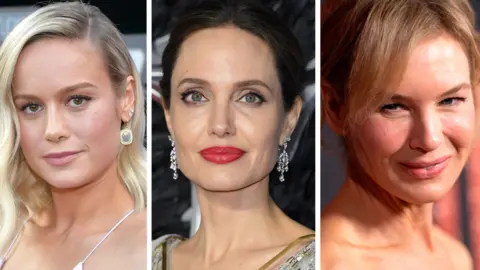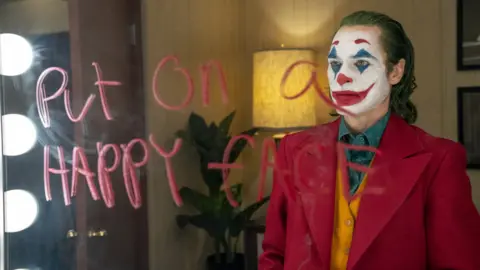Record number of female film leads, US study suggests
 Getty Images
Getty ImagesFemale characters had their biggest-ever representation in box office films last year, according to research.
The Center for the Study of Women in Television and Film said a record 40% of 2019's highest-grossing US movies had women in a lead role - up 9%.
But black and minority ethnic (BAME) women are being left behind, the annual report also suggests.
Films on the list include Avengers: Endgame, Captain Marvel, Joker and Maleficent: Mistress of Evil.
Compiled from information from Box Office Mojo, the study said that 43% of the biggest movies had a male lead, while titles with equal male/female leads or ensemble casts accounted for the remaining 17%.
Film critic Dr Rebecca Harrison told the BBC the increase of representation in leading women on screen is "great" for megastar white actresses like Brie Larson, Angelina Jolie and Renee Zellweger, as well as Scarlett Johansson and Margot Robbie - who received two Bafta nominations in the same category this week. But "for women of colour" she added, "representation is still appalling".
The main female characters in question proved to be white 68% of the time, compared to their black colleagues (20%). Asian women made up 7% of the roles and Latina women 5%.
"The intersectional oppressions are alive and well," said Dr Harrison.
 Getty Images
Getty ImagesThe survey - which began in 2002, when big female lead roles were at a lowly 16% - arrives after a week of criticism around the unfair treatment of women and BAME people, either side of the camera.
It's a Man's (Celluloid) World, which is the name of the study, suggested that in films with at least one female writer and/or director, 58% of the main characters were female.
That figure dropped to 30% in films made by men.
'Very disappointed'
Last week the Golden Globes again did not recognise any women in their five-strong all-male pool for best director - won by Sam Mendes for his war epic, 1917. And this week no women were nominated in the same category for a seventh year in a row at the Baftas.
Amanda Berry, head of the British Academy of Film and Television Arts, admitted she was "very disappointed" by the lack of diversity.
Deputy chairman Krishnendu Majumdar said the lack of female directors nominated was an "industry-wide problem" and they were "fiercely doing something about it" with schemes like Elevate, which supports talent from underrepresented groups.
In 2018, the academy announced new diversity quotas - or "eligibility criteria" - for two of the award categories; best outstanding British film and outstanding debut by a British writer, director or producer, in a bid to "support an open, accessible and inclusive industry".
Dr Harrison believes that while it's fine for the institutions to say they're disappointed, they now have to "actively work hard to change the rules" of how the industry operates "otherwise, it's just meaningless headlines".
"Michelle Williams was talking the other day at the Golden Globes, and she gives a big empowered speech about how women need to vote for themselves and lots of white women applauded, while lots of women of colour were immediately speaking to the fact that white women have always voted in their own interest and always acted in their own interest.
"I think that you can see that in the film industry.
"One of the arguments in this is that representation on screen improves when diversity behind the camera improves as well."
 Warner Bros
Warner BrosShe went on: "So if there are more white women getting access to the director's chair and to production roles, that's great. But that's not going to translate into improved representation for women of colour and men of colour, who have also lost out here.
"The one thing that did surprise me slightly was the news that it's actually studio films where the most positive increases have happened and indie films have gone backwards."
The academic and author believes the big studios often get "a lot of justified criticism" about the fact that they're "only doing representation in a kind of a corporatised way", by using the same safe familiar and sellable white faces.
Female-speaking characters overall, according to the research conducted out of San Diego State University, fell by 1% to 34%.
"If they think that it will improve box office, they will do it. Otherwise they just don't bother."
Despite the upward trend at the top, Dr Harrison believes it's the role of film critics to continue also to hold producers of independent films - "the spaces where women have historically had better access" - to account with regards to diversity in order to keep "affecting positive change".
'Did they die at the end?'
The new statistics mainly analyse female performances in a quantitative, rather than qualitative way, and should therefore be approached with caution.
The Bechdel test is another measure often used for looking at the representation of women in fiction and raises questions like - does the piece have at least two named women in it? Who talk to each other? And about something besides a man?
At last year's Cannes Film Festival, director Quentin Tarantino shut down one journalist's attempts to ask him about the fact that "very talented actress" Margot Robbie had relatively few lines in his Golden Globe-winning Once Upon a Time... In Hollywood.
"Well I just reject your hypothesis," he replied bluntly.
 Getty Images
Getty ImagesFemale characters were far less likely to have leadership roles or identifiable jobs than their male counterparts, the study said, with 26% of women in leadership roles, compared with 74% of men.
Dr Harrison thinks it is "all well and good saying, 'OK women were protagonists in 40% of the films'", but that we don't really know what their exact role was in those films "without looking at the kind of qualitative textual analysis that goes on, beyond just the numbers".
"So were these women protagonists in films being represented in a positive way?" she asked. "Did they die at the end? Were they the survivors of some kind of horrific sexual abuse on screen? Were they given lots of dialogue?"
"I think all of these conversations are always about trying to find a balance between celebrating the positive, but also making sure that we're constantly paying attention to areas for improvement," she concluded.

Follow us on Facebook, or on Twitter @BBCNewsEnts. If you have a story suggestion email [email protected].
